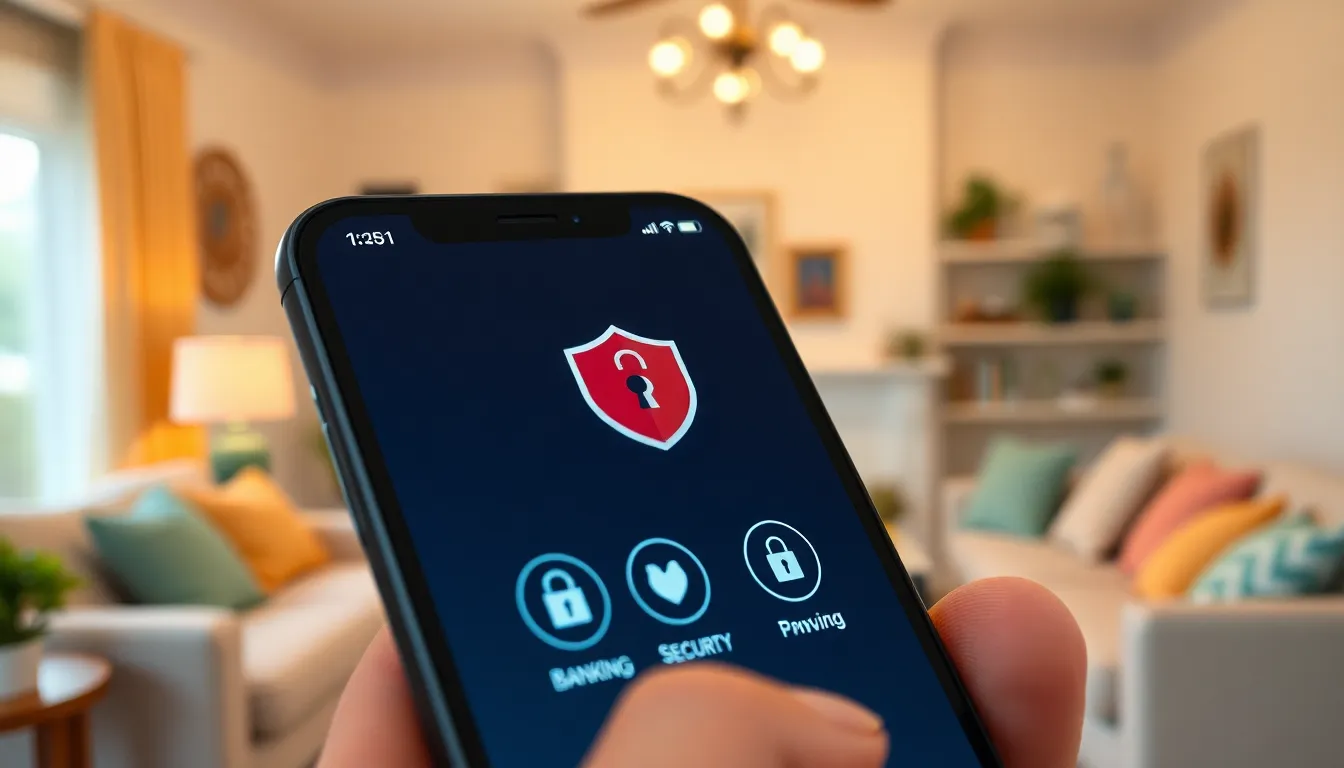In today’s fast-paced world, mobile banking apps have become the trusty sidekicks of financial management. They allow users to transfer money, check balances, and even pay bills—all from the comfort of their couch. But as convenient as they are, a nagging question lingers: are these apps as secure as they claim to be?
Picture this: you’re lounging in your pajamas, sipping coffee, while your bank account dances at your fingertips. But wait! What if that convenience comes with a side of risk? Navigating the world of mobile banking security can feel like walking a tightrope. With hackers lurking like ninjas in the shadows, it’s crucial to understand just how safe these digital wallets really are. Let’s dive into the world of mobile banking security and uncover the truth behind those shiny apps.
Table of Contents
ToggleUnderstanding Mobile Banking Security
Mobile banking security concerns arise from the need to protect sensitive financial information. These digital platforms connect users to their financial institutions, enabling transactions anytime, anywhere.
What Are Mobile Banking Apps?
Mobile banking apps facilitate access to one’s bank account directly through smartphones or tablets. Users can check balances, transfer funds, and pay bills with just a few taps. Each app features unique interfaces and functionalities but aims to simplify mobile financial management. Major banks and financial institutions provide dedicated applications designed to offer a seamless banking experience.
Importance of Security in Mobile Banking
Security plays a vital role in mobile banking due to increasing cyber threats. Protecting personal data helps prevent identity theft and financial loss. Utilizing strong encryption technology ensures that sensitive transactions are secure from unauthorized access. Banks frequently implement multifactor authentication, adding another layer of security. Regular updates and monitoring enhance the overall safety of these apps, keeping users’ financial information secure.
Common Security Features of Mobile Banking Apps

Mobile banking apps implement various security features to safeguard users’ financial information. Among them, two-factor authentication and encryption protocols stand out as essential components.
Two-Factor Authentication
Two-factor authentication adds an extra layer of security. Users verify their identity through something they know, like a password, and something they have, typically a mobile device. Many banks send a one-time code to the user’s phone, which must be entered to complete a transaction. This approach significantly reduces the risk of unauthorized access. Security experts recommend enabling this feature for all banking-related activities to enhance account protection. Regularly updating the authentication methods ensures a higher level of defense against potential threats.
Encryption Protocols
Encryption protocols serve as vital safeguards for data in transit. Mobile banking apps use strong encryption methods, such as AES-256, to protect sensitive information. These protocols convert data into unreadable formats, only decipherable by authorized users. When users conduct transactions, encryption secures details like account numbers and personal information from cyber threats. Adopting robust encryption standards is critical in establishing user trust. Financial institutions routinely conduct security assessments to ensure encryption practices remain effective against evolving cyber risks.
Potential Risks of Mobile Banking Apps
Mobile banking apps offer convenience, but they come with inherent risks that users must recognize. Understanding these potential threats can help users safeguard their financial information.
Phishing Attacks
Phishing attacks pose significant risks to mobile banking users. Cybercriminals often use fake emails or messages to trick individuals into revealing sensitive information like passwords or account numbers. These fraudulent communications may appear legitimate, making it hard to distinguish them from genuine correspondence. Users should always verify the source of any request for personal details. Staying vigilant against suspicious links is essential; clicking on them could lead to fake websites designed to capture sensitive data. Regularly monitoring bank statements for unauthorized transactions also serves as a protective measure against phishing attacks.
Malware and Hacking Risks
Malware and hacking present serious concerns for mobile banking app users. Malicious software can infiltrate devices, compromising sensitive information stored in banking apps. Users often unwittingly install malware by downloading apps from untrusted sources or clicking on unsafe links. Employing reputable security software significantly reduces the chances of infection. Staying updated with app versions also strengthens security against vulnerabilities that hackers might exploit. Moreover, public Wi-Fi networks can expose users to hacking risks; avoiding banking transactions on unsecured connections is a smart practice. Protecting devices with strong passwords further minimizes the likelihood of unauthorized access.
Best Practices for Ensuring Security
Ensuring security in mobile banking requires diligence. Users must adopt several best practices to protect their sensitive information.
Use Strong Passwords
Creating strong passwords significantly enhances account security. Passwords should contain at least twelve characters, combining uppercase letters, lowercase letters, numbers, and special symbols. Regularly changing passwords adds another layer of protection against potential breaches. Avoid using easily guessable information such as birthdays or names. Utilizing a password manager can assist in generating and storing complex passwords securely. Additionally, ensure that each account has a unique password to prevent hackers from accessing multiple accounts in case one password is compromised.
Keep Your App Updated
Keeping banking apps updated is crucial for security. App developers frequently release updates that include security patches to fix vulnerabilities. Users should enable automatic updates for convenience. Regularly updating the operating system on a device also enhances overall security. Outdated apps may lack essential security features, exposing users to risks. Review update logs periodically to stay informed about improvements and features. Avoid using an app if it hasn’t been updated in a long time, as this might indicate potential security issues. Commitment to updating apps ensures protection against emerging cyber threats.
Mobile banking apps offer convenience but come with security challenges that users must navigate. By understanding potential risks and implementing best practices like two-factor authentication and strong passwords, individuals can significantly enhance their safety. Regular updates and vigilance against phishing attacks further protect sensitive information. With the right precautions in place, users can confidently manage their finances through these digital platforms while minimizing the threat of cybercrime. Trust in mobile banking can grow as both users and financial institutions prioritize security measures.





